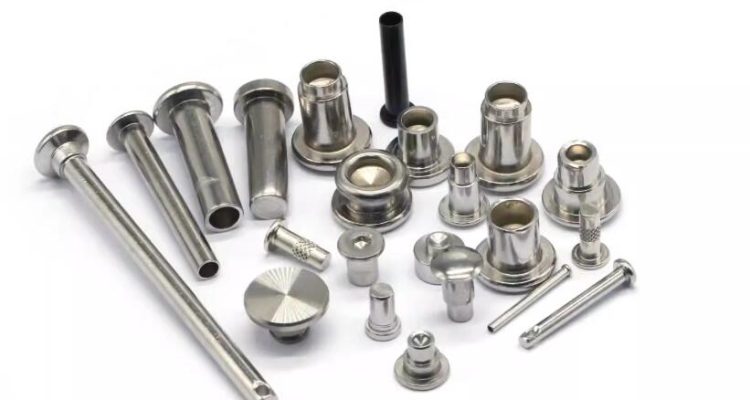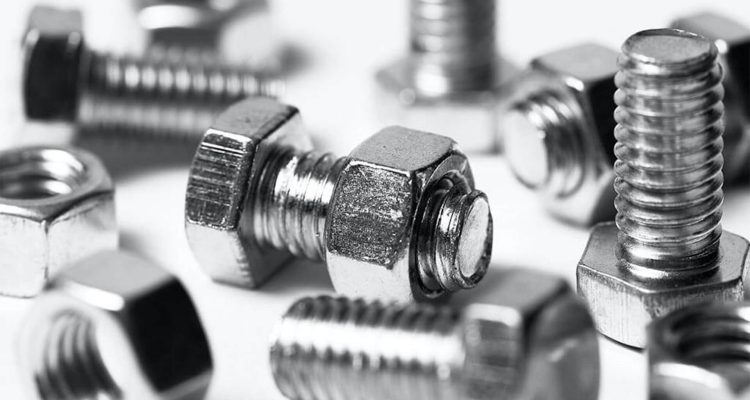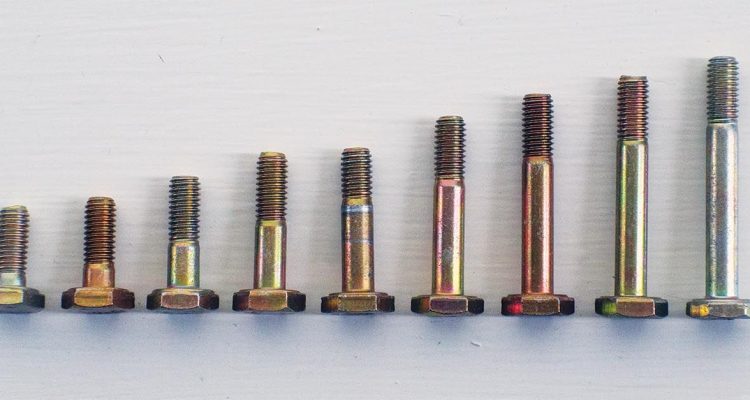Blind Aluminum Rivets
Features and Advantages
A blind rivet is a tubular rivet with a mandrel through the center, and a head that forms an other head on one end when the mandrel is pulled into or against the tubular portion of the rivet. The rivets are formed by a tubular body with a mandrel that crosses its center. As the mandrel is pulled on, the body expands, creating a good tight fit. Blind rivets are valuable because they are quick, easy to use and provide a strong durable bond with the minimum of effort. They are designed for applications where it is unfeasible or undesirable to access the rear side of the material, such as added reliability to high vibration areas or to help reduce circular cracking.
Uses in Various Industries
Blind aluminum rivets are widely used in industries in many applications. They are used to join body panels and they are also used for assembling the interior parts of the car to achieve a secure and vibration resistant connection. In the electronics industry, where enclosures and circuit boards need to be securely fastened for electrical insulation and mechanical robustness, blind rivets are used. Blind Rivets are a useful way for the construction of homes to secure gutters, roofing materials and window frames. An important case includes using blind rivets in aircraft manufacturing to secure panels of the fuselage and wings together thus allowing structural continuity and aerodynamic efficiency.
Installation Process
Blind aluminum rivets are easy to install and create a reliable bonding. Drill a hole for the rivet body the same size through the joining materials Feed the blind rivet into the hole with the mandrel extending through the material. And finally you will pull the mandrel through the body of the rivet using a rivet gun. When that happens, the human body expands and the layer of material beneath contracts accordingly to hold onto it. As soon as the mandrel breaks, it results in a joint that is clamped in place. Assembly of an average rivet is completed in less than 30 seconds, rendering it useful for both manual and automated assembly lines.
Technical Specifications
Available in different sizes and materials to accommodate all applications, blind aluminum rivets are used in many parts of the industry. Diameters range in standard sizes from 3/32 to 1/4 in., with lengths from 1/4 to 1-1/2 in. Their shear strength can even surpass 1,500 pounds, while these rivets have a tensile load of 2,000 pounds. Mandrel and body materials are optional, typically aluminum, stainless steel, or nickel-plated steel. These criteria make it possible for blind rivets to serve in a wide range of industrial and commercial applications.
Industry Facts
Blind aluminum rivets are used in some of the most important industries today. This is particularly important in the aerospace sector, which uses blind rivets extensively when assembling aircraft skins and frames to provide lightweight, high-strength joints. These rivets provide electrical isolation and mechanical stability between components in the electronics industry. Blind rivets are crucial in automotive manufacturing to connect interior and exterior panels, with the fitness for use under vibration and stress levels. This is seen, for example, in the use of blind rivets during the construction of the Burj Khalifa, where they support the building both structurally and visually.
Tubular Aluminum Rivets
Benefits and Typical Uses
Tubular Aluminum: Tubular aluminum rivets have a hollow body which is lightweight and provides for a very easy application compared to any solid rivet. They are designed to require less installation force making them ideal for high-speed assembly operations. These rivets come in handy when it comes to reducing weight in high volume applications (eg in the automotive and electronics industry).
And Detailed Installation Guide
- Drill the Hole: Start by drilling a hole where both connected materials meet, make sure that you drill the tubular rivet the same diameter as its body. If you are using a 3/16 inch diameter rivet your hole should also be a 3/16 in diameter.
- Install the Rivet: Set the rivet into the hole you just drilled. The hollow end must extend on the other side of the material.
- Flare the Hollow End With a rivet setting tool, flare the hollow end of the rivet. The application size and scale dictates if this has to be done with a manual or pneumatic tool.
Install the Rivet: The material is compressed by the setting tool which in turn flares the tube, securing the rivetPERATURE The mild sheet metal or the micarta, mother organics requires from 300 to 500 metrical aid thereof for fitting over rivet which makes the fitting through the compression process to each other.
Technical Specifications
Available in a variety of sizes and materials, tubular aluminum rivets. Some common sizes are 1/16 to 1/4 inch diameter and 1/8 to 1 inch long. This is done usually done with aluminum alloys such as 5052 or 6061, which give the optimal balance of strength and corrosion resistance relevant to the task. With a shear strength of 25,000 PSI and a tensile strength of 30,000 PSI, the rivets are ideal for light to medium duty applications.
Industry Facts
They may not be right for every industry, but tubular aluminum rivets are the right choice for many. These are used throughout the Electronics industry for circuit board and electronics enclosure assembly, providing both a secure and lightweight fixing. For more than a century the automotive sector has employed tubular rivets to connect parts such as brake linings, body panels, and interior assemblies, where any benefits in lessening the weight of parts helps with performance and fuel economy.
Tubular rivets join parts of office chairs, tables, and storage units in a seamless, strong connection common in furniture production. For instance, one office chair can be built using more than 100 tubular rivets to lock all its parts properly and give it strength which can endure regular usage.
They are also used in HVAC systems to fasten ducts and panels together which ensures the permanent and air tight connection. Tubular rivets can be easily installed and are capable of holding a system together even at negative pressure and extreme temperatures – that is why they are invaluable to the HVAC industry.
In-Depth Demolition Installation Techniques
Tubular aluminum rivets are typically installed using a manual, semi-automatic, or fully automatic riveting machine. Manual installation usually requires a handheld rivet setter and a hammer or mallet. Semi-automatic machines use pneumatic or hydraulic pressure to put the rivet while fully automatic pull guns are part of more advanced manufacturing lines for high-volume operations.
Drive Aluminum Rivets
Key Characteristics
Installation of Drive aluminum rivets is relatively easy compared to other fasteners. Solid shank with Drive Pin This means they do not need access to the backside unlike other rivets. A drive pin that expands the rivet shank to attach the materials is what makes them great for blind fastening applications. This type of fasteners are generally used where a permanent connection is required, due to its increased mechanical strength (cinching principle) it is completely tamper-proof.
Applications and Benefits
Simple and efficient, these drive aluminum rivets find widespread usage in diverse industries. The signage industry uses them to mount signs / plaques onto walls and posts, providing a firm grip that lasts long. Drive rivets are used in the construction industry to secure light panels together and insulation boards. AutomotiveThey are commonly used to fasten interior trim and panels because of the close fit and the clean finished appearance it provides.
Where traditional riveting may not be practical, drive rivets get the job done. In this regard, they are one of the most common choices for fastening HVAC system panels, ducts, keeping everything securely and air-tightly in place. In such as unit, it is possible that 500 or more drive rivets may be needed to fix each and every part in place, in order to withstand the forces that the unit is exposed to in operation.
Drive Aluminum Rivet easy and quick installation:
- Drill Your Hole – Using your drill bit, drill a hole in the two items you are joining together (the hole size should match your rivet shank) As an example, if using a 3/16 diameter drive rivet, then a 3/16 diameter hole should be drilled.
- Pop the Rivet: Put the rivet into the hole you drilled. Make sure the head of the rivet is flush on the surface of the mat.
- Will a hammer or rivet set to drive the pin into the shank. By doing this the shank is opened up, making it tight and keeping the materials closed. Normally, 200-300 pounds of force are needed to set the pin, depending on the size of the rivet and material thickness.
- It provides a connection that is locked and prevents independent from being disassembled (e.g. for certain applications the joint must be impossible to disassemble).
Technical Specifications
Drive rivets are also produced in a range of sizes and materials, allowing for them to be used in multiple applications. Sizes vary but usually fall between 1/8-inch to 1/4-inch diameter and 1/4-inch to 1-inch length. It is developed from 5052 and 6061 high-strength aluminum alloys that provide corrosion resistance and impactsresistance. Generally these rivets provide a shear strength of 20,000 PSI, tensile strength of 25,000 PSI and are best used in light to medium-duty applications.
Industry Facts
In different high-demand industries, drive aluminum rivets play a critical role. In the electronics sector, they are commonly used to fasten housings and machinery parts together because they offer a tamper-resistant and durable joining solution. In the automotive sector these rivets are used, for example, to fasten interior panels and trim notes that are subject to vibration and wear so that a clean and reliable fit remains. Drive rivets for constructionProvides strong and easy to use fixings for insulation boards, panels and more in the construction industry

Flat Head Aluminum Rivets
Unique Features
Flat head aluminum rivets have broad flat head which furnishes large bearing surface. This type of design is done to spread the load over a wider region of the material to avoid material deformation at the joint and to provide more strength at the joint. Applications: Flat head rivets are used when the surface must be smooth and no protrusion is permitted either for aerodynamics or for aesthetic reasons.
Advantages in Particular Applications
Flat head aluminum rivets are so important to industries that desire a flush structure. Aerospace industry would use these rivets to fix the aircraft skin and panels ultimately for causing less drag during the airflow and a beautiful exterior view. The Boeing 787 Dreamliner utilizes flat head rivet in many different locations due to its aerodynamic performance for example.
Often in the automotive sector, flat head rivets are employed to join body panels and interior trim, providing a clean and tidy appearance to the vehicle. In the electronics sector, these rivets are used to fasten components and casings where a smooth face is desired to avoid any snags and maintain overall design aesthetics.
Installation Instructions
The installation of flat head aluminum rivets requires you to be as precise as possible to get the perfect flush finish. Follow these detailed steps:
Create a Hole: Drill a countersunk hole through the materials! The hole needs to be the same diameter and depth as the head and shank of the rivet. E.g. 3/16 inch Flat head rivet so drill a 3/16 in hole with a countersink that will fit the rivet head.
Install the Rivet
Distorting the Tail: Deform the tail of the rivet by hammering it or use a rivet gun to ensure tight joint. During the overall process to expand the tail and lock the materials together, called “bucking.” Bucking a rivet properly during the installation process will keep its head flush with the material surface, preserving the material’s intended aerodynamic or appearance-related characteristics.
Technical Specifications
There are many types of flat head aluminum rivets in different sizes and materials. Typical diameters are between 1/8 inch to 1/4 inch and lengths between 1/4 inch and 1 inch. They are also made from high-strength aluminum alloys, 2117 and 7050, that give superior corrosion resistance usually coupled with exceptional machinability properties. Most of these rivets sport a shear strength of 26,000 PSI and a tensile strength of 32,000 PSI, which indicates they are made for heavy duty applications.
Industry Facts
Flat head aluminum rivets are essential to businesses that require a perfectly tight finish and strength. These are aerospace Grade rivets and are used in applications where the rivet must be as flush as possible to reduce drag and improve fuel efficiency in the assembly of aircraft fuselages and wings. Flat head rivets are used to fasten exterior body panels and trim in the automotive industry to achieve a more finished and seamless exterior.






